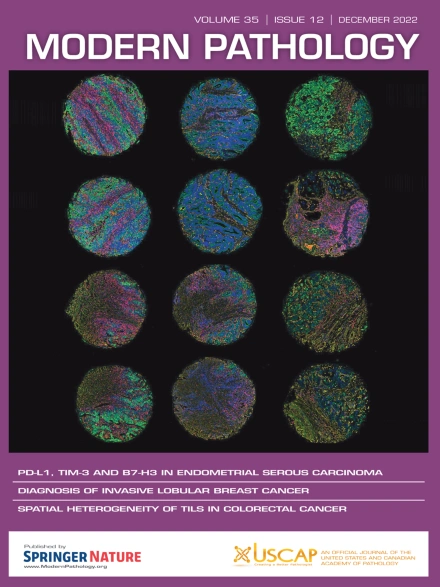卵黄囊分化的性腺外泌尿道肿瘤:源自潜在尿路上皮癌的临床、组织学和分子证据。
IF 7.1
1区 医学
Q1 PATHOLOGY
引用次数: 0
摘要
卵黄囊外肿瘤是罕见的,很难与体细胞衍生的非生殖细胞肿瘤(如卵黄囊分化的癌)区分开来,而且关于泌尿道中这种现象的资料非常有限。我们收集了10例原发于泌尿道的卵黄囊纯粹或广泛分化的肿瘤,以阐明它们与生殖细胞肿瘤的关系,并在此描述这些病变的临床、组织学和分子特征。老年男性(男女比例为8:2,平均年龄= 78岁)、疾病中心沿尿路粘膜、既往盆腔放疗相关(40%)、既往或随后频繁诊断常规尿路上皮癌(40%)反映了尿路上皮癌的典型临床和人口学特征。病理上,所有肿瘤均表现出腺卵黄囊肿瘤的形态学和免疫组织化学特征,与其他生殖细胞肿瘤亚型无相关性。一部分病例有其他组织学特征,包括肉瘤样或鳞状特征(20%)或常规尿路上皮癌(10%)。大多数肿瘤表现出侵袭性的临床行为,有7/8的随访病例显示复发、转移或因疾病死亡。分子分析,包括基于小组的DNA测序(n=8)和荧光原位杂交(n=2),对一部分病例没有发现同工染色体12p的证据,但确实显示TP53(8/ 8,100%)、TERT启动子(3/ 8,38%)和几个参与染色质重塑的基因之一,包括KDM6A、CREBBP和KMT2D(5/ 8,63%)的复发性突变,以及涉及染色体9p的复发性缺失,包括CDKN2A/MTAP位点的纯合缺失(3/8)。38%)——一系列的发现与尿路上皮癌已建立的分子图谱惊人地相似。这些研究结果表明,原发的卵黄囊外肿瘤累及尿路通常是一种罕见的、诊断上具有欺骗性的、临床上具有侵袭性的尿路上皮癌。本文章由计算机程序翻译,如有差异,请以英文原文为准。
Extragonadal Urinary Tract Neoplasms With Yolk Sac Differentiation: Clinical, Histologic, and Molecular Evidence of Derivation From Underlying Urothelial Carcinoma
Extragonadal yolk sac tumors are rare and can be difficult to distinguish from somatically derived, non-germ cell tumors such as carcinomas with yolk sac differentiation, and there are very limited data available on this phenomenon in the urinary tract. A cohort of 10 tumors primary to the urinary tract with pure or extensive yolk sac differentiation was assembled to clarify their relationship to germ cell tumors, and herein, we describe the clinical, histologic, and molecular features of these lesions. The predilection for older males (8:2 male:female ratio, mean age = 78 years), the epicenter of disease along the urinary tract mucosa, association with prior pelvic radiation (40%), and frequent previous or subsequent diagnosis of conventional urothelial carcinoma (40%) mirrored the typical clinical and demographic features of urothelial carcinoma. Pathologically, all tumors demonstrated typical morphologic and immunohistochemical features of glandular yolk sac tumors and were not associated with other germ cell tumor subtypes. A subset of cases harbored additional histologic elements including sarcomatoid or squamous features (20%) or conventional urothelial carcinoma (10%). Most tumors showed aggressive clinical behavior with 7/8 cases with available follow-up demonstrating recurrence, metastasis, or death from disease. Molecular analysis, including panel-based DNA sequencing (n = 8) and fluorescence in situ hybridization (n = 2) on a subset of cases, showed no evidence of isochromosome 12p but did reveal recurrent mutations in TP53 (8/8, 100%), the TERT promoter (3/8, 38%), and one of several genes involved in chromatin remodeling including KDM6A, CREBBP, and KMT2D (5/8, 63%), and recurrent deletions involving chromosome 9p, including homozygous deletion encompassing the CDKN2A/MTAP locus (3/8, 38%)—a constellation of findings strikingly similar to the established molecular landscape of urothelial carcinoma. These findings indicate that primary extragonadal tumors with yolk sac differentiation involving the urinary tract frequently represent a rare, diagnostically deceptive, and clinically aggressive form of urothelial carcinoma.
求助全文
通过发布文献求助,成功后即可免费获取论文全文。
去求助
来源期刊

Modern Pathology
医学-病理学
CiteScore
14.30
自引率
2.70%
发文量
174
审稿时长
18 days
期刊介绍:
Modern Pathology, an international journal under the ownership of The United States & Canadian Academy of Pathology (USCAP), serves as an authoritative platform for publishing top-tier clinical and translational research studies in pathology.
Original manuscripts are the primary focus of Modern Pathology, complemented by impactful editorials, reviews, and practice guidelines covering all facets of precision diagnostics in human pathology. The journal's scope includes advancements in molecular diagnostics and genomic classifications of diseases, breakthroughs in immune-oncology, computational science, applied bioinformatics, and digital pathology.
 求助内容:
求助内容: 应助结果提醒方式:
应助结果提醒方式:


